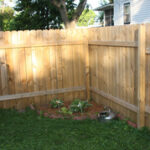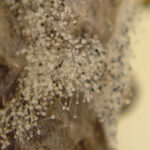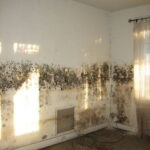Staining a wood fence not only improves the appearance of the natural wood, but it also prevents mold and mildew growth and provides UV protection to the boards, helping to keep them from rotting out. Even fence boards that are pressure treated can be damaged by the sun’s rays if they aren’t properly protected, and staining the fence is one way to ensure that your investment lasts as long as possible.
Unlike painting, staining a fence provides a thinner, clear protective seal that you can see through. It allows the wood’s natural texture and grain pattern to show through. This is particularly attractive when paired with craftsman-style homes that feature dark colored trim, but can compliment practically any style of home decor.
The best and quickest way to stain a fence is by using a paint sprayer. There are two different types of sprayer that you can use for this purpose. The first is an electric sprayer, and the second is an air-powered spray gun. Either will work, but you’ll want to use an electric sprayer if you don’t have access to an air compressor or own an air-powered spray gun. They can be quite expensive if you have to purchase them, and can easily double the cost of your entire fence project. By contrast, electric sprayers are much less expensive and can usually be purchased at any major home improvement retailer.
For the project, you’ll need more than just the stain. You’ll also need a quantity of old rags that you don’t mind destroying and a face mask. Wood stains, and in particular outdoor wood stains with UV protective qualities tend to have far more chemicals in them that are hazardous to breath. Since you are spraying the material, rather than brushing it on, you’ll find that the atomized stain is much cloudier and easier to breath in. This makes a proper face mask an absolute necessity. You will also need a paint cup and approximately one gallon of water, depending on the type of stain you purchase.
Fully transparent stains are generally sprayable right out of the can. On the other hand, semi-transparent stains usually have to be reduced to use with a spray gun. Depending on the type of paint, whether it is oil-based or water-based, you may need paint reducer rather than water. Paint reducer is used with oil-based paint. To check what kind of stain you have, take a small amount of the stain and attempt to mix it with water in the paint cup. If the two mix, then the stain is water-based. If they don’t,then the stain is oil-based.
Reduce the stain with either water or reducer until it has the consistency of water. Mix it completely, and then pour the stain into the paint reservoir of the spray gun. With the reservoir filled, plug the spray gun into either an electrical outlet or an air compressor. When the pressure has built up to approximately 30 pounds per square inch within the gun, spray the fence panels starting at the top and moving in vertical strokes. Make certain that you spray areas where water can rest, as well. This includes areas such as the cross supports and the top surface of the fence slats.
There are two further options that you can choose at this point. When using stain on wood, you usually wipe away the excess with a rag. This leaves a more natural-appearing wood finish. However, if you are using relatively low-grade wood with semi-transparent stain, you can skip this step, as you will find that the semi-transparent stain will cover the imperfections in the wood and provide a more attractive surface appearance. The stain should dry to the touch after just an hour or so. Once it has, apply a second coat of stain over the first, again making certain that you get stain into all the hidden surfaces that you can spray. Once you have finished this, your fence will be protected from the elements for as long as three years, at which point you will want to spray it again to maintain the fence’s attractive natural wood look.
Sources:
Wood defender.com: “How to stain a fence”:
http://www.wooddefender.com/howtostainafence.php
Peter A. Kirsch-Korff: “Wood Staining Tips for Outdoor Decks, Fences, Gates & Arbors”: http://www.kirsch-korff.com/Pages/guide_staining_a_wooden_pergola_deck_fence.htm




